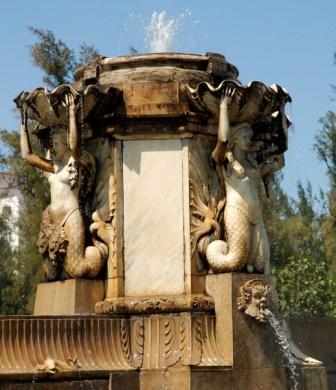Fountains of Delight
By Maria Matienzo Puerto

I’d never given thought to those jobs. I’d never even asked myself who takes care of the trees in my city, or what’s the name of the man who passes by at dawn sweeping the street clean of what others have tossed on the ground.
Although “The Little Prince” is one of my favorite books, I hadn’t stopped to think about the importance of those kinds of job until I talked to Him.
For ten long years he had been jailed for ideological differences, and when he left prison the only job he could find was with city services as a “fountain operator” (that’s what the sanitation department called that position). His job back then was to turn on and off fountains, although the first one he was supposed to operate hadn’t functioned for years.
After a while he was promoted to a more important position; he was made responsible for “La Cascada” (the waterfall) on the grounds of the National Hotel, on the side facing busy 23rd Street and the Malecon seawall.
He went there every day, where his responsibility was always the same one: overseeing the cleaning, making sure kids didn’t dive in, and turning on and off the motor that circulated the polluted water drawn from the adjacent coast.
He worked there for a number of years until – despite the trumpeting by the Little Prince – he decided to give that job up. He didn’t believe, as I do, in the poetry of that vocation.
Despite the fact I’m not courageous enough to give up my occupation as a writer to go running to take his job, what he’ll never know is that his story served to get me to begin reading, with other eyes, what was told to me by some of the monuments in this city.
A long time ago each one of the city’s fountains took on a life of its own, so they speak even when they’re not even there.
The Alamar neighborhood, for example, is possibly such a rough place because it doesn’t have a single fountain, not even one with salt water. There’s one in East Havana (Ciudad Camilo Cienfuegos), but the last time I saw it, it needed major repair. It’s obvious the one in Cotorro was recently constructed; it evidences the telltale signs of emotional detachment and poor taste in the way it was built. In addition, in my walk through the neighborhood of Guanabacoa, though its name means “the land of water,” I haven’t seen a single water fountain.
With others – the old ones, and the most beautiful – their original inspiration has often been forgotten. This has occurred at the mausoleum erected in the early 20th century in honor of the general that later became president, José Miguel Gomez. (The monument is situated at the corner of G and 29 streets.)
Sometimes you can detect a bit of sarcasm in their silent waters; perhaps those being honored feel they are owed at least a little explanation.
Similarly, at the entrance of Obispo Street, the largest fountain in Latin America in the 19th century remained dry for a long time. Now, however, that vital fluid is again pumping through it. Notwithstanding, you have to remember that it’s located in one of Havana’s neighborhoods with the most problematic water supply systems.
But hey, not everything’s so bleak; just a few blocks away new fountains are being built in the middle of the renovated historic district, where – for the satisfaction of Cubans and tourists – the flow of life continues.





